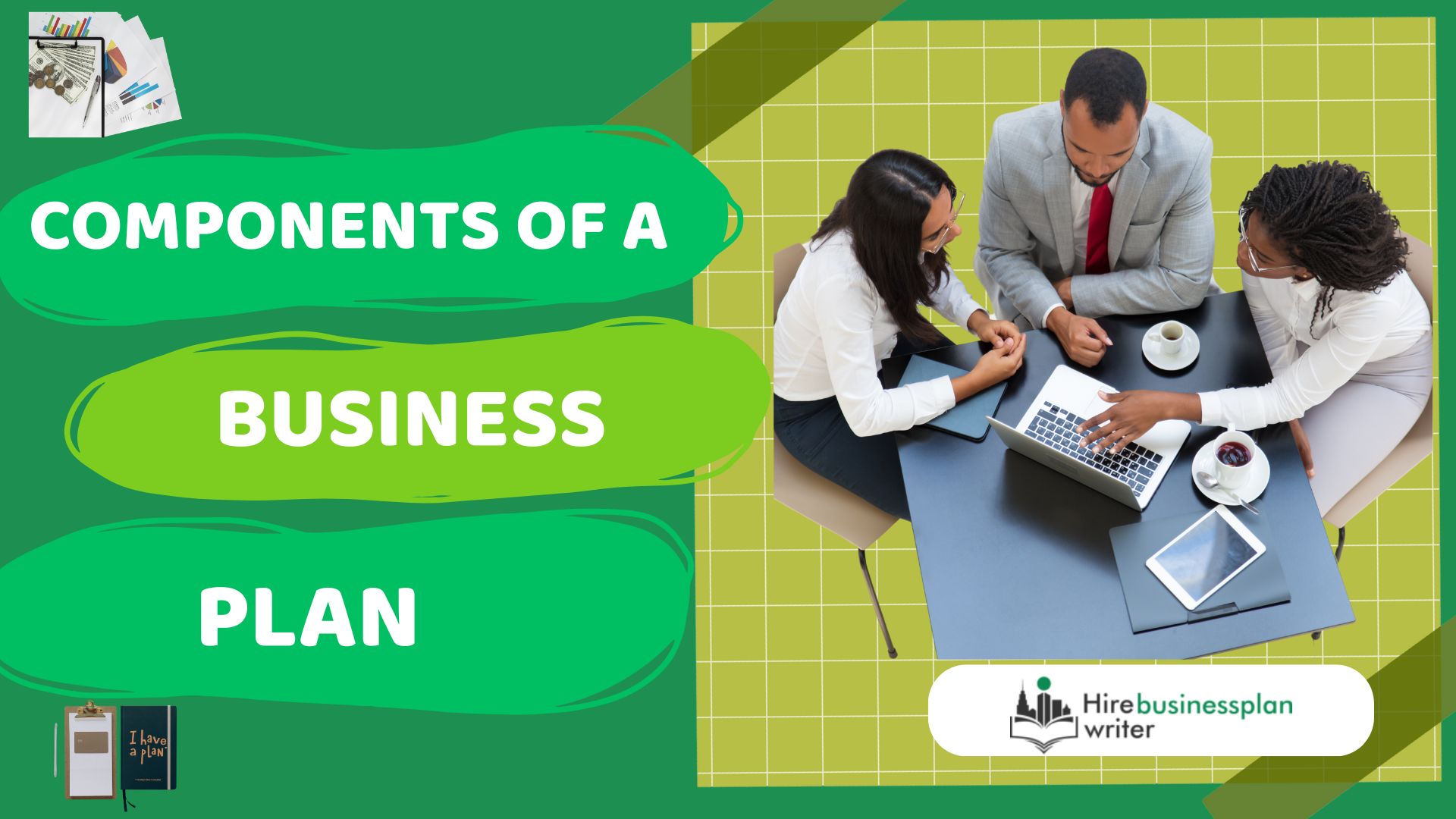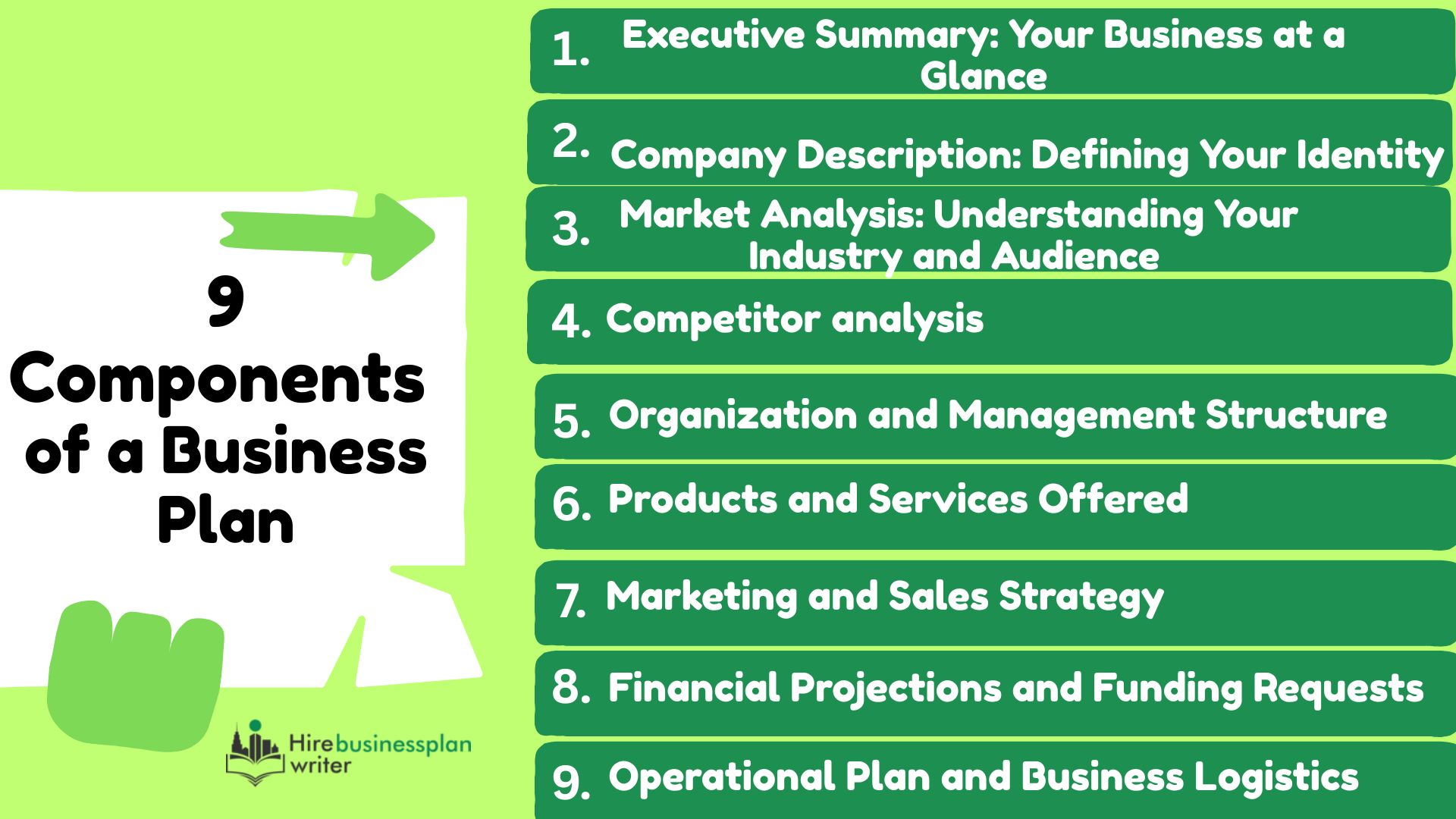Components of a Business Plan
April 04, 2025 · 6 min read

Components of a Business Plan
A business plan is a simple written guide that shows how a business will start, grow, and succeed. It has different parts, also called components or elements, that help explain the whole idea. These parts are important because they help business owners stay on track and make smart decisions.
Each element gives clear information about one area of the business, like what the business does, who it helps, how it makes money, and what it needs to grow.
When all the parts are put together, they give a full picture of the business. These components are useful for both new and growing businesses. They also help when asking for loans or support from investors. If a business plan lacks key elements, it can lead to confusion or failure.
So, it is important to understand each part and how it works. In the next section, we will look at the 9 most important components of a business plan and how they support startup and growth success.
What Is a Business Plan ?
A business plan is a document that explains what a business does and how it will succeed. It outlines a company’s goals and the strategies to achieve them. This business plan helps business owners stay organized and make smart choices to ensure the business stays on course. It also helps other stakeholders, like banks or investors, understand the business better.
Why is a Business Plan Important?
A business plan is important because it helps people understand how a business will work. It shows the goals of the business and the steps to reach them. This makes it easier for the owner to stay focused, avoid mistakes and minimize risks.
A business plan also helps when asking for money from banks or investors because it explains the business clearly. It shows how the business will make money and grow over time. A good business plan also helps find problems early, so they can be fixed quickly. A business owner can make better choices each day.
The viability of a business is well outlined by a business plan as it helps confirm that the idea you have makes business sense. It also helps keep track of the progress and stay on the right path. A business plan is like a map that shows where the business is going. Without it, the business may get lost or fail.
9 Components of a Business Plan
The 9 components of a business plan are the most important parts that make the business plan complete. Each part shares helpful information about how the business will run and grow.
These parts work together to show the big picture of the business. Some talk about what the business sells, who the customers are, and how the business will make money. Others explain how the business is managed and what it needs to succeed.
All the elements are easy to follow and help others understand the business better. A strong business plan uses these 9 elements to guide the owner and support smart decisions. These components also help when asking for support from banks or partners.
If one part is missing, the business plan may not be clear or helpful. That is why it is important to learn about all the 9 components and how they work together. Below are these components described in detail, and an image of a list of these components.

1. Executive Summary: Your Business at a Glance
The executive summary is the first part of a business plan. It gives a quick look at the whole business in a short and simple way. This part helps readers understand what the business is about before they read the rest of the business plan. It should be clear, short, and easy to follow. A good executive summary should help catch the attention of investors or partners right away.
What Should Be Included in the Executive Summary?
It should include the name of the business, what it does, who it serves, and what makes it special. You can also add a short note about your goals and how the business will make money. If you are asking for money or support, say how much you need and what it will be used for.
How to Write a Strong Opening That Hooks Investors
Start with a strong sentence that makes people want to learn more. Use simple words to explain why your business is a good idea. Show that you understand your market and are ready to take action. This will help make a strong first impression.
2. Company Description: Defining Your Identity
The company description is the part of the business plan that talks about who you are and what your business stands for. It helps people understand your purpose, your goals, and how your business will run. This element gives a clear picture of your business identity and what makes it different from others. It also tells readers what your business believes in and how it plans to grow.
Mission, Vision, and Values
This part explains why your business exists , the mission, what it wants to become, its vision, and the important ideas it follows, which are its values. These help guide your choices and show others what your business stands for.
Legal Structure and Ownership
Under this segment, you share if your business is owned by one person, a group, or a company. You also say how it is set up legally, is it a sole proprietorship or a partnership. This helps people know who is in charge and how the business is managed.
Business Model Overview
Business model helps explain how your business makes money. You talk about what you sell, who buys it, and how your business keeps running. It shows that you have a plan to stay in business and grow.
3. Market Analysis: Understanding Your Industry and Audience
Market analysis is the part of a business plan that helps you understand the industry you are in and the people you want to serve. It shows that you have done your homework and know what is happening around your business. This component helps you make smart choices by learning about trends, customer needs, and your competition. It also shows investors that you are ready for the market.
Industry Overview and Trends
This part explains what is going on in your business area. You talk about how big the industry is, if it is growing, and what changes are happening. It helps you see if there is a good chance for your business to succeed.
Target Market Breakdown
Here, you describe the people who are most likely to buy from you. You explain their age, habits, needs, and what they are looking for. Knowing your target market helps you offer the right products or services. It also helps you reach them in a better way.
4. Competitor analysis
Competitor analysis is the part of the business plan where you look at other businesses that offer the same products or services. It helps you understand who they are, what they do well, and where they are weak. This helps you find ways to stand out and do better. When you study your competitors, you can also learn what customers like and do not like. This information helps you make smart choices for your business.
Competitive Edge
Your competitive edge is what makes your business different or better than others. It could be lower prices, better customer service, or something new that others do not offer. This segment shows why customers would choose your business instead of other businesses offering the same product or services. A strong competitive edge helps you grow and stay ahead in the market. Knowing what makes you special is a big step toward success.
5. Organization and Management Structure
The organization and management structure part of a business plan shows who is in charge and how the business is run. It helps people understand the roles of each person in the team and how they work together. A clear structure makes it easier to manage the business and solve problems. It also shows that the business has the right people to make good decisions and grow.
Leadership Team and Roles
This section talks about the main people in the business, like the owner, managers, and other key staff. It explains what each person does and why they are important to the business.
Organizational Chart and Legal Entity
Here, you can show a simple chart that explains who reports to who. You also explain how the business is set up legally, such as a sole proprietorship, partnership, or company.
Advisory Board and External Support
Some businesses get help from outside experts. This part explains if you have an advisory board or outside support, like lawyers or accountants, who give advice or help when needed. Having this kind of support shows that your business has strong guidance.
6.Products and Services Offered
The products and services component explains what your business sells or offers to customers. It helps people understand the main things your business provides and why they are helpful. This part shows how your products or services solve problems or meet customer needs. It also helps investors see if your business can grow and succeed.
Core Offerings and Features
This section talks about the main products or services your business gives. You should explain what they do, how they work, and why people would want them.
Unique Value Proposition (UVP)
Your UVP is what makes your products or services special. It explains why customers should choose you instead of others. This could be better quality, faster service, or something that saves people money.
Lifecycle and Development Roadmap
Talk about the stage your product or service is in. Is it already being sold, or is it still being worked on? You can also share future plans for making it better. This shows that your business is thinking ahead and ready to grow.
7. Marketing and Sales Strategy
The marketing and sales strategy element explains how your business will reach customers and make sales. It shows the steps you will take to let people know about your products or services. This part is important because even the best products need a good plan to get noticed. It also helps show how your business will grow and keep customers coming back.
Positioning and Branding
Positioning and branding explains how you want people to see your business. It includes your business name, logo, and message. It also helps build trust and makes your business easy to remember.
Pricing and Promotion Plans
Here, you explain how much your products or services cost and why. You also share your plans to let people know about your business through ads, social media, or other ways.
Sales Funnel and Customer Acquisition
This shows how you plan to get new customers. It explains the steps from first contact to making a sale. A strong sales funnel helps you turn interest into action and grow your business.
8. Financial Projections and Funding Requests
The financial projections and funding requests section explains the money side of your business. It shows how much you expect to earn, spend, and save in the future. This component helps others see if your business can grow and stay strong. It is also important if you are asking for money to help start or grow your business.
Revenue Forecast and Cash Flow Statement
This part shows how much money you think your business will make over time. It also explains how money will move in and out of your business each month.
Balance Sheet Overview
In a balance sheet, you share a simple list of what your business owns and what it owes. This helps show your business’s overall financial health.
How Much Funding Do You Need and Why?
If you need money from investors or a loan, explain how much you need and what you will use it for. Be clear and honest so people can trust your plan. This section helps prove that your business idea makes sense and is worth supporting.
9. Operational Plan and Business Logistics
The operational plan and business logistics element explains how your business will run each day. It talks about the steps needed to deliver your products or services to customers. This part helps others see that your business is ready and organized. It shows how your business will manage space, tools, systems, and supplies to stay on track.
Location and Facilities
This segment explains where your business is based. It includes your office, store, or any other space you use to work or serve customers.
Supply Chain and Fulfillment
This is where you describe how you get the items you need to run your business and how you deliver products or services to your customers. This helps show that you can meet customer needs on time.
Technology and Systems Infrastructure
It talks about the tools, machines, or software your business uses. This section shows how technology helps you work faster, stay organized, and keep things running smoothly. Having a strong system helps your business grow and solve problems easily.
Resumes, Letters of Intent, or Contracts
You can include team resumes, agreements with partners, or letters from people who want to work with your business. These show that you have the right team and support to succeed.
Tips of How to Structure and Present Your Business Plan Professionally
This is a very important segment that gives helpful tips on how to make your business plan look clean, easy to read, and professional. A good structure helps readers follow your ideas and understand your business better. When your business plan is clear and neat, it also builds trust with investors, banks, or partners. You do not need to make it fancy, but it should be well organized and simple to read.
Design and Formatting Tips
Basically, use clear headings, short paragraphs, and simple fonts. Add bullet points or charts when needed to explain your ideas better. Keep the layout neat and use space wisely.
Common Mistakes to Avoid
Do not use hard words or long sentences. Avoid missing parts like the financial plans or market research. Make sure to check for spelling and grammar mistakes.
Digital Tools for Writing a Business Plan
You can use tools like Google Docs, Microsoft Word, or business plan templates online. These tools help you write faster, stay organized, and save your work easily. A well presented business plan makes a strong first impression.
Get Help for Writing a Professional Business Plan
Writing a business plan can be hard if you do not know where to start and this is the reason why many people get help from experts who do this every day. These experts can be business plan writers, business plan consultants, or even full business plan writing services. A business plan writer puts your ideas into clear and easy words that make sense to investors.
Business plan consultants give advice and guide you step by step. They help you think about your goals, your financial plans, and how your business will grow. Some people choose full services that handle everything from beginning to end. These services have a team that works together to understand your business and write a strong business plan. When you work with the right people, your business plan becomes more powerful and more likely to succeed. Getting help also saves time and lets you focus on other parts of your business.


